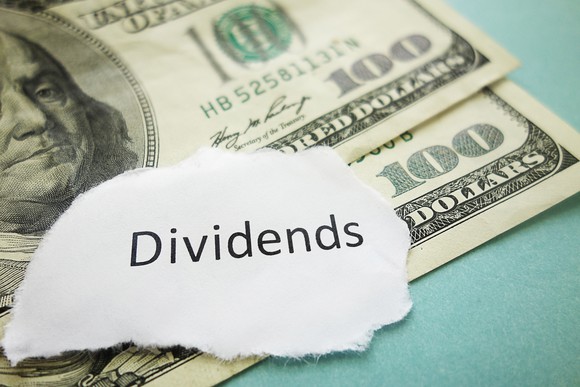The market has been hard on ExxonMobil, Best Buy, Covanta, Enterprise Products Partners, and Brookfield Property Partners lately — but that makes for a great opportunity for dividend investors.
If you’re on the hunt for dividend-paying stocks, we’ve got you covered. There are several solid dividend-paying stocks today that have been out of favor for one reason or another, and that makes for a great opportunity to get a higher than average yield.
We asked five of our contributors to each highlight a stock they think should be on an investor’s buy list today. Here’s what they had to say.
A dividend stock for decades
Todd Campbell: If you’re anything like me, you like a bargain. While some bargain-bin stocks aren’t worth owning, one that investors ought to be considering for their portfolios right now is ExxonMobil (NYSE:XOM).
ExxonMobil’s shares recently sold off sharply alongside a drop in crude oil prices. However, short-term thinking probably isn’t the best bet when it comes to evaluating the potential for an energy Goliath like this. A growing global population and expansion in important emerging markets means that the global demand for energy over the long term is heading up, not down. And given that ExxonMobil is one of the largest producers, refiners, and retailers of energy, it’s probably going to benefit.
Adding conviction to that thinking is the fact that despite the weakness in crude and natural gas prices this past year, ExxonMobil is still turning a profit. Last quarter, its second-quarter earnings were $1.7 billion. That’s a pretty good profit considering that oil prices are a fraction of their price five years ago.
Admittedly, no one knows when energy prices will rebound or stocks like ExxonMobil will head higher. But with a track record that includes an average 6.4% annual dividend hike over the past 33 years, it might be best not to bet against this company.
The yield is higher than it appears
Tim Green: Consumer electronics retailer Best Buy (NYSE:BBY) may not be widely known as a dividend stock, but it’s one worth considering. The company pays a dividend of $0.28 per share each quarter, good for a yield of 3.35%. On top of the regular payment, an annual special dividend sweetens the pot even further. Best Buy has paid a special dividend in each of the past two years, and while the policy isn’t guaranteed to continue, it boosts the true dividend yield closer to 4.7%.
Best Buy has turned itself around over the past few years by cutting costs, shedding international divisions, and focusing on competitive prices and customer service. The company produced adjusted earnings of $2.78 per share last year, a number that backs out various one-time costs, putting the P/E ratio at 12 and the payout ratio, including the special dividend, at 56%.
Further dividend increases will likely require Best Buy to grow its earnings, but a high dividend yield means that dividend growth doesn’t need to be all that fast in order to make the stock attractive. A lack of exciting new products has been a problem for Best Buy, which has struggled to consistently grow comparable-store sales. But double-digit e-commerce growth and an increased focus on appliances and services should help combat weak sales of PCs and phones.
Best Buy has transformed itself into a far leaner company over the past few years, and the stock deserves a look from dividend investors.
One investor’s trash…
Daniel Miller: Investors looking for an intriguing dividend stock to scribble on their shopping list need look no further than Covanta (NYSE:CVA), which has been on my own list this year. Most investors have never heard of the company, as it delves into an industry few care to look into: waste.
Covanta owns or operates waste-to-energy plants that process roughly 20 million tons of waste each year, incinerating the nonhazardous solid waste into steam and electricity. It then turns around and sells the energy back to the world.
Incineration is widely accepted in Europe, and with Covanta’s Dublin project roughly 70% complete, and its presence in China, the company is already one of the world’s largest waste-to-energy operators worldwide. One recent victory for the company was winning New York City’s contract, which could speed up the adoption of incineration, rather than traditional landfill disposal, to other large U.S. metropolitan areas.
Covanta’s business model is great, in theory, as its customers pay it to take waste — the fuel it uses to create energy — and then sells the end-product as a typical business does. As with any stock, though, there are risks involved, as lower-cost landfills are still readily available in many regions.
Thus, the dilemma: Covanta either builds more incinerators near large sources of waste to become more cost-competitive, or takes the longer approach and waits as cities grow large enough that landfills become less of an attractive option.
It’s definitely an intriguing stock for further research, with a yield of 6.3%, according to Morningstar’s estimates. If investors believe more U.S. cities will follow NYC’s lead and that the company will bring more of its business to the bottom line after the Dublin project is fully operational, Covanta could be a big long-term winner.
A steady pipeline of payouts
Tyler Crowe: Too often, companies in the oil and gas industry all get lumped into one category, when in fact, each one’s business model can be wildly different. Despite the volatility in commodity prices. Enterprise Products Partners (NYSE:EPD) continues to crank out consistent and growing cash flow that it has used to raise its payout to shareholders every quarter for the past 48 quarters in a row.
There are lots of reasons the company is able to do this, but the two most important are its business structure and management’s approach to growth. Many other companies own large diversified pipeline and infrastructure networks like Enterprise, but what Enterprise does with that network is what makes it unique. Around 80% of its customers pay it a fixed fee to rent space in that pipe regardless of whether they use it or not, which gives the company a strong base of cash flow from which to work. It also helps that 69% of the company’s customers sport investment-grade credit ratings, so there isn’t too much worry about a customer not paying the bills.
Then there is the way management has handled its growth and payout over the years. Unlike many other pipeline companies that have paid out every dollar possible to investors and relied on external capital to fund growth, Enterprise has elected to balance its payouts such that it can reinvest in the business and avoid needing to go to the debt or equity market every time it needs a dollar or two to fund new projects. This has given the company much more flexibility in the good times and bad.
At a distribution yield of 5.8%, it isn’t the least expensive shares have been in a while, but it’s still a respectable price for a steady dividend payer that should be on a dividend investor’s radar.
The real estate mogul
Matt DiLallo: Real estate is a great place to shop for a lucrative income stream. While there are plenty of companies in that sector to choose from, Brookfield Property Partners (NYSE:BPY) tops my list. Not only does it pay a pretty lucrative quarterly distribution with a current yield of 4.6%, but it expects to grow that payout by 5% to 8% per year. On top of that, its global real estate portfolio has several catalysts to drive capital appreciation.
The bulk of Brookfield Property Partners’ portfolio consists of iconic office properties in gateway markets like New York, London, Toronto, and Sydney, as well as trophy retail assets in top markets across the U.S. These assets are more than 90% leased to long-term tenants, which provides steady cash flow to support the company’s distribution. Meanwhile, these assets have solid appreciation potential via increased rents and redevelopment opportunities.
In addition to its core portfolio, Brookfield intends to invest up to 20% of its capital in opportunistic real estate assets. These include both mispriced properties and those with value-add potential. At the moment, about 15% of its capital is invested in such assets, including stakes in portfolios that own multifamily, industrial, hospitality, and self-storage properties. Not only do these assets generate current cash flow for the company, but each has untapped upside. In fact, Brookfield believes that its opportunistic investments can generate 18% to 20% returns on equity, compared to just 10% to 12% returns from its core portfolio.
Bottom line, investors shopping for some income should take a close look at Brookfield Property Partners, which is a one-stop shop for real estate exposure.
A secret billion-dollar stock opportunity
The world’s biggest tech company forgot to show you something, but a few Wall Street analysts and the Fool didn’t miss a beat: There’s a small company that’s powering their brand-new gadgets and the coming revolution in technology. And we think its stock price has nearly unlimited room to run for early-in-the-know investors! To be one of them, just click here.
Daniel Miller has no position in any stocks mentioned. Matt DiLallo owns shares of Brookfield Property Partners and Enterprise Products Partners. Timothy Green owns shares of Best Buy. Todd Campbell has no position in any stocks mentioned. Tyler Crowe owns shares of Enterprise Products Partners and ExxonMobil. The Motley Fool owns shares of ExxonMobil. The Motley Fool recommends Enterprise Products Partners. Try any of our Foolish newsletter services free for 30 days. We Fools may not all hold the same opinions, but we all believe that considering a diverse range of insights makes us better investors. The Motley Fool has a disclosure policy.
















